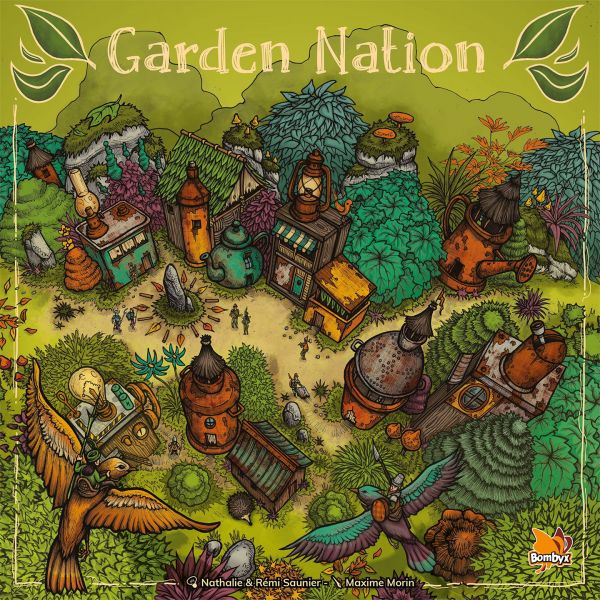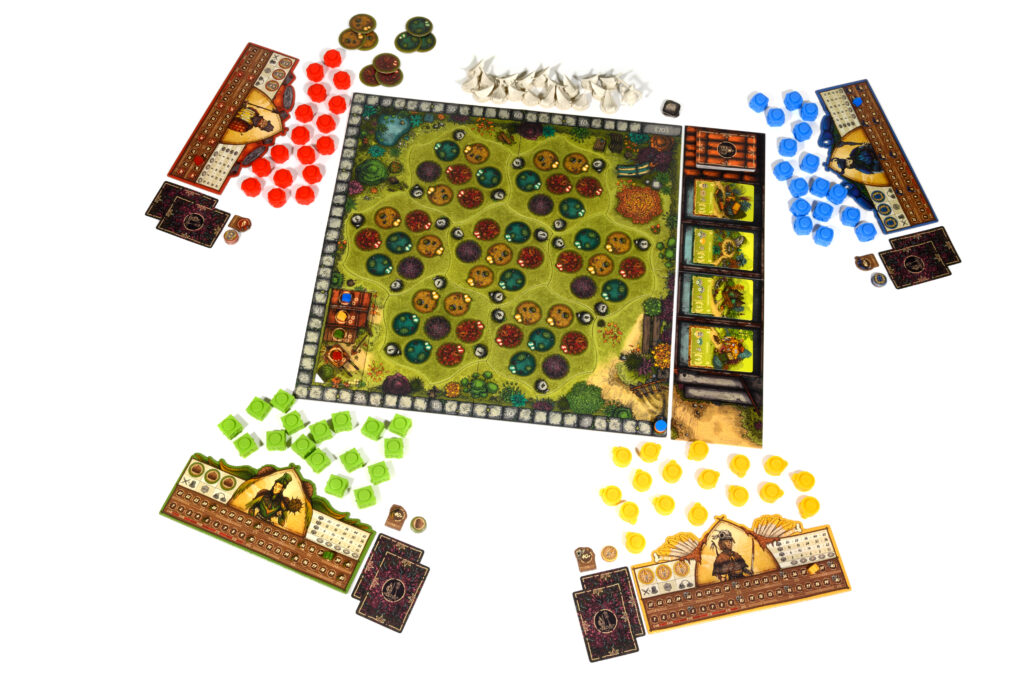Build Verdant Cities and Gain Control in Garden Nation

This abstract area control game from designers Remi and Nathalie Saunier challenges 2-4 players to develop one of seven garden territories to meet objectives and earn points.
Gameplay
Each player will take a player board, a meeple, a token, and a hedgehog of their color. The token will be placed along the scoring track, the meeple will be placed on the tracks on each player board to represent the number of inhabitants available, and the hedgehog will be used to determine player order. Players will also take a number of buildings in their color determined by the player count.
The goal of Garden Nation is to score the most points by meeting the objectives outlined in the Common Objective cards. These cards will present scenarios where adjacency, color of areas, height of buildings, and the addition of a roof (which does not cost inhabitants to place) will gain the player who first completes it the points shown. It is scored immediately, the Common Objective card is removed, and a new card is drawn. Meanwhile, players will also select two Secret Objective cards at the beginning of the game that will grant them additional point opportunities at game’s end similar to objectives on the Common Objective cards, but may have special conditions such as having a building that is four floors high without a roof, or a bunch of two or three-floor buildings on a particular area color without a roof that is worth points for each that fulfills the objective.
After determining the first player, they will place one building in one of seven areas within one of the seven territories. The placement of the building will determine where the torticrane miniature is placed, which denotes the next territory that will be built in. For example, if a player places a building in the upper left area of a territory, the next turn will occur in the corresponding upper left territory. The first player will then determine who goes next, and the following player will take two actions. Play continues this way until the round is done and all hedgehogs have been placed to denote player order. Then control of each of the seven territories is determined, with the player having the most buildings gaining two inhabitants and any ties grant the tied players one inhabitant each.
Inhabitants are important because they are spent to build in a given territory. When a building is placed in one of the colored areas on a board, it will indicate a cost (1-5). This cost is the number of inhabitants a player will have to spend to place a building in that area. If a player decides to build another level to a building they already have on a space, they will add the cost of one additional inhabitant for each floor. For example, if a player wishes to place a second floor on an existing building in a space that costs four inhabitants, it will cost the player four inhabitants to place the second floor. Inhabitants will also determine end game points, as each section on the player board will show a point total that is gained or lost by where the inhabitant meeple is on the track by game’s end. Players may decide to abandon a building in a territory, where they not only regain the floors they have used but will gain back a number of inhabitants determined by the value of the area and the floors they are removed. These values are shown on each player board.
Players are also able to perform special actions up to four times during their turn, as shown on their player boards. One of these actions is a hostile takeover, where they return any building tiles on one area to the player and build their own building in that space. Players who take over the space must pay double the inhabitant cost of what’s currently occupying the space, while the player who loses the space will gain double the inhabitants. For example, if a player takes over a space that had a two-floor building on a 3 space, it would cost them 10 inhabitants to take that space while the player losing their control of the space would gain 10 inhabitants. The second action is to move the torticrane to a territory plus or minus one from the number of the territory the torticrane currently occupies (each territory is numbered 1-7). The final action allows players to move a roof from one of their buildings to another of their buildings.
Play continues until one player has run out of all their floors. The remaining players will get one last turn, area control of territories is determined, and then final points from Secret Objectives and inhabitants is determined and added to points scored from Common Objectives already completed. The player with the most points wins.

Review
Garden Nation is a cleverly fun and simple abstract that challenges with each play. While trying to fulfill both Common and Secret Objective cards, players will also strategically build to ensure they set themselves up for success in future turns, while also trying to shut out other players from building on areas in territories where control may be tenuous or that may prevent themselves from fulfilling wanted objectives.
The objective cards are the magic ingredient in Garden Nation, because without them much of the game feels aimless. At first, it may feel overwhelming to navigate which of the Common Objective cards to go for, and if any of them align with your Secret Objective cards. However, the game moves quickly and deftly as players place floors and construct buildings, so they help players begin to focus on specific ideas and plays.
And that’s the beauty of Garden Nation: it unfolds quickly and elegantly. Each move is important, but not so important that it can’t be undone and some benefit gained from correcting any mistakes. Often, it’s not a mistake being corrected but rather a strategic move to abandon a building that was used to fulfill a Common Objective card that is no longer of use save for the inhabitants gained by abandoning it.
However, Garden Nation is not perfect. The theme is cute, but pasted on. It’s not as if each player (representing one of four clans) has any unique or asymmetrical power, and the story is nothing more but a reason to justify the area control aspect of the game. In the end, Garden Nation is a dazzling abstract game that doesn’t require a theme to be enjoyable. But it certainly helps the game board and three-dimensional pieces pop off the colorfully green, red, and yellow board.
If you’re looking for a fun abstract area control game that has as much strategy as it does cuteness, Garden Nation is going to be a game worth investing time and money in. It seems to have a lot of rules at first, but after the first turn it’s clear what actions one can take and which strategies are at their disposal.
Pros: Wonderfully clever abstract game, Lots of options and variability in strategy, Easy to set-up, teach, and play
Cons: Theme isn’t integral to the gameplay




